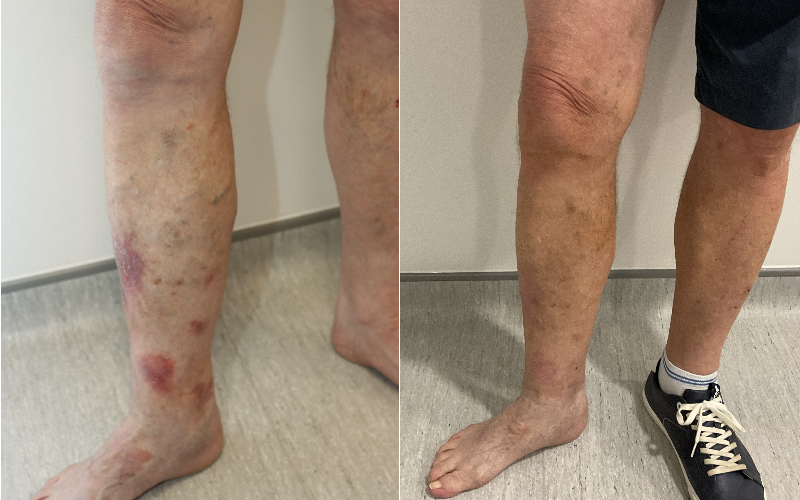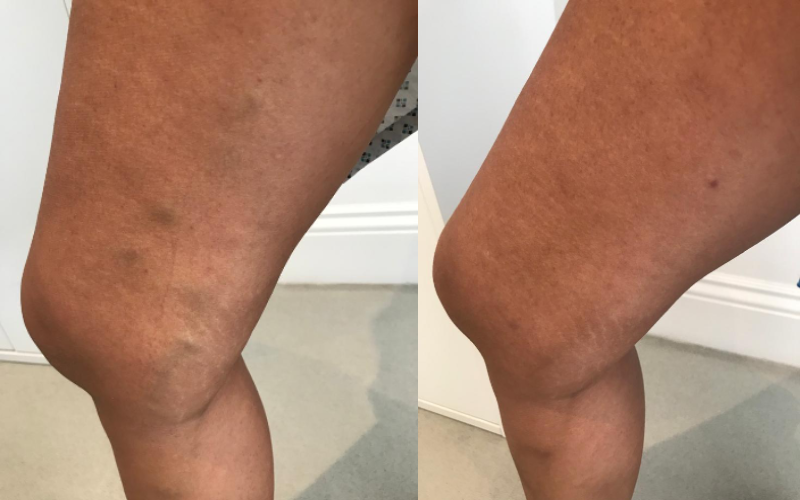Varicose veins
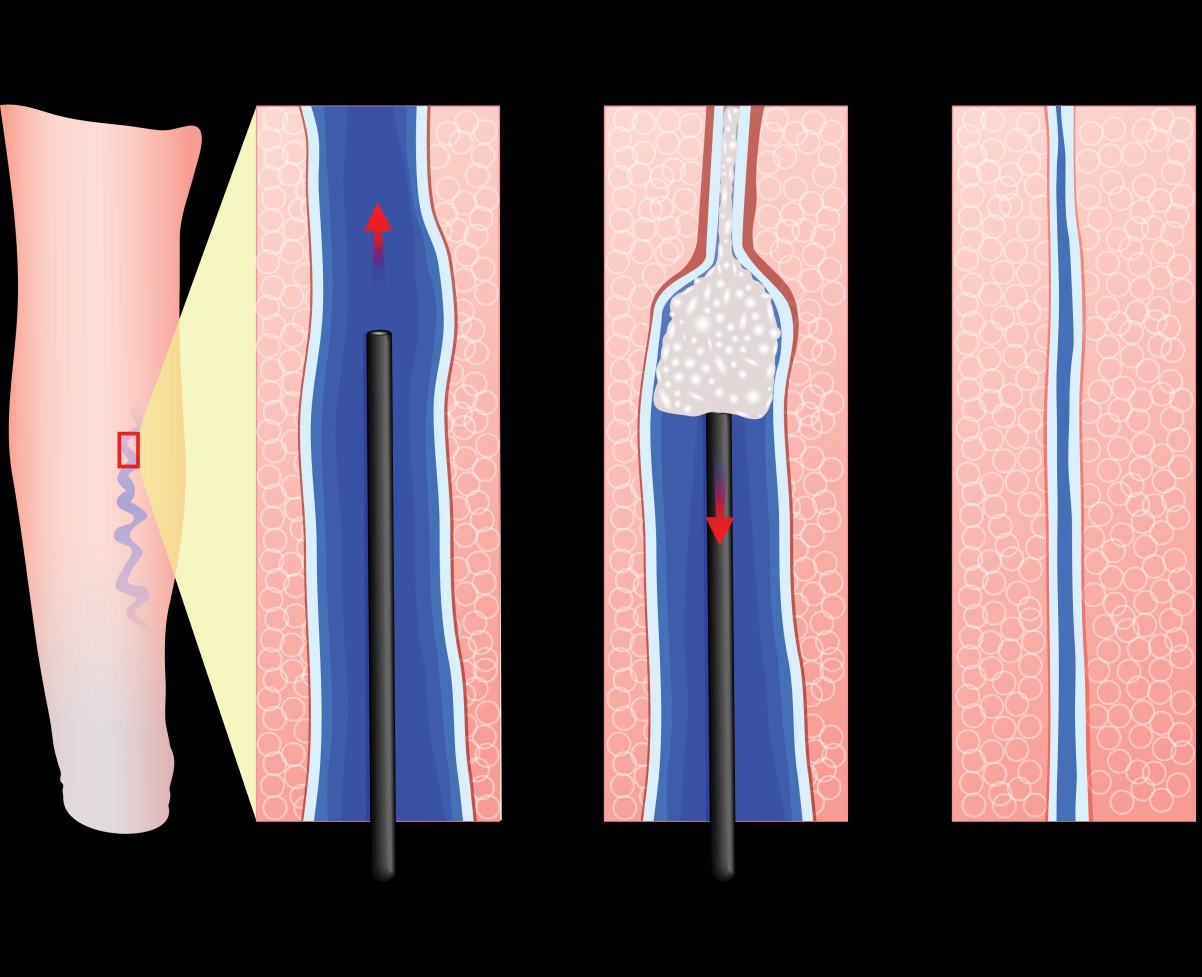
Available Modalities
All modalities of treatment available at Integura
The current modalities of treatment available for treating varicose veins are
- Endovenous thermal ablation – Laser
- Mechano chemical Ablation
- Foam Sclerotherapy
- Cyanoacrylate glue
- Multiple phlebectomies
Mr Sridhar will suggest the best option for you based on your clinical and personal needs and based on his wide experience and updated knowledge.
Endovenous Laser Ablation (EVLA)
EVLA is an established gold standard technique for the treatment of varicose veins and has replaced traditional surgical techniques in the treatment of varicose veins in most cases. The abnormal vein is heated by a laser. A wire with a laser tip is introduced into the vein via a catheter using a minimally invasive keyhole approach. The laser tip is advanced to the highest point to be treated or up to 2cm from any junction with the deep veins. The laser is then activated, which destroys the internal walls of the vein. The body then absorbs the dead tissue, getting rid of the varicose vein. the procedure is carried out under local anaesthetic, using a technique called tumescent anaesthesia. where a large volume of dilute anaesthetic solution is injected along the leg through small needle pricks. It has a 98% success rate and maintains that rate for ten years.
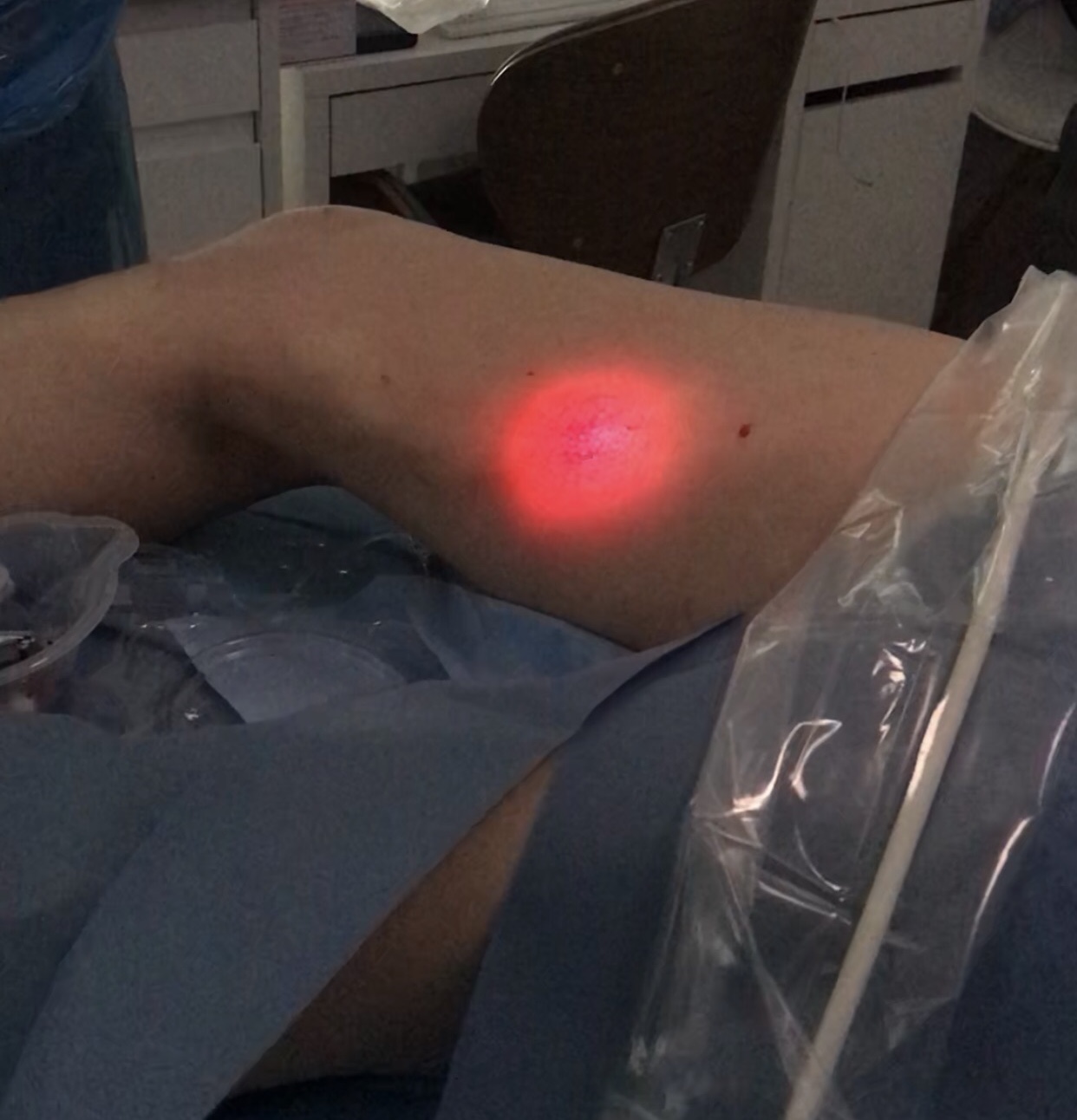
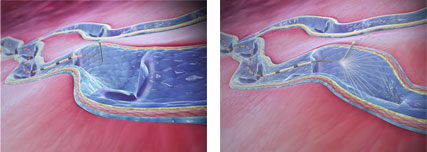
ClariVein®
ClariVein®is another technique in the endovenous varicose vein treatment known as mechanochemical venous ablation which utilises a revolutionary catheter tip which spins within the vein, damaging the walls of the vein. A chemical sclerosant is used in conjunction with this to destroy the vein. The advantage of this technique is that it does not generate heat, and therefore does not require the use of tumescent anaesthesia. This means less bruising, no pressure in the leg from anaesthetic, and less post-operative discomfort and a quicker return to normal. This is a newer technique than EVLA, and therefore has less long term data to back its effectiveness. However, current data so far continues to support this modality as a treatment that is shaping up to be as effective as EVLA.
Glue Technique
This is the most recent advancement in the management of varicose veins. This technique uses superglue to stick the vein walls together. In due course, the glue initiates a scarring process and the veins shrivel and get destroyed.
Unlike laser and radiofrequency, this technique does not require numerous injections. One single injection at the point of entry is all that is required. Once complete there is no need for compression stockings. Pain and discomfort are reported to be less after glue usage.
The disadvantage is that the method has been approved for clinical use only recently. Hence there is not much evidence of long term results (10 years and beyond). Endothermal ablation has evidence for a 97% occlusion rate at 10 years. The glue is applied 5cm away from the junction unlike laser/Radiofrequency (2cm from the junction). Therefore the risk of recurrence is theoretically high for glue.
If you choose to have glue to treat your veins, you agree to be part of clinical governance meaning you will agree to be seen annually for 5 years to check the veins by ultrasound and leg clinically.
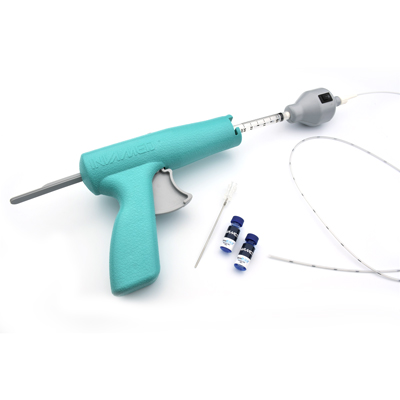
Foam Sclerotherapy
If other modalities mentioned above are unsuitable for you, sclerotherapy or chemical destruction of the vein will be another option.
This treatment involves injecting special foam into your veins. The chemical in the foam chemically burns the veins and destroys them. The destructed vein is later removed by the body.
The injection may sometimes need to be guided by an ultrasound scan. It is possible to treat more than one vein in the same session.
Foam sclerotherapy does not require local anaesthetic. Tiny needles, generally used in babies, are used here.
After sclerotherapy, the veins become red, angry, and inflamed before settling down. You may require treatment more than once before the vein fades. There is a chance that new veins may appear due to the closure of the varicose veins.
The veins treated by sclerotherapy never return.
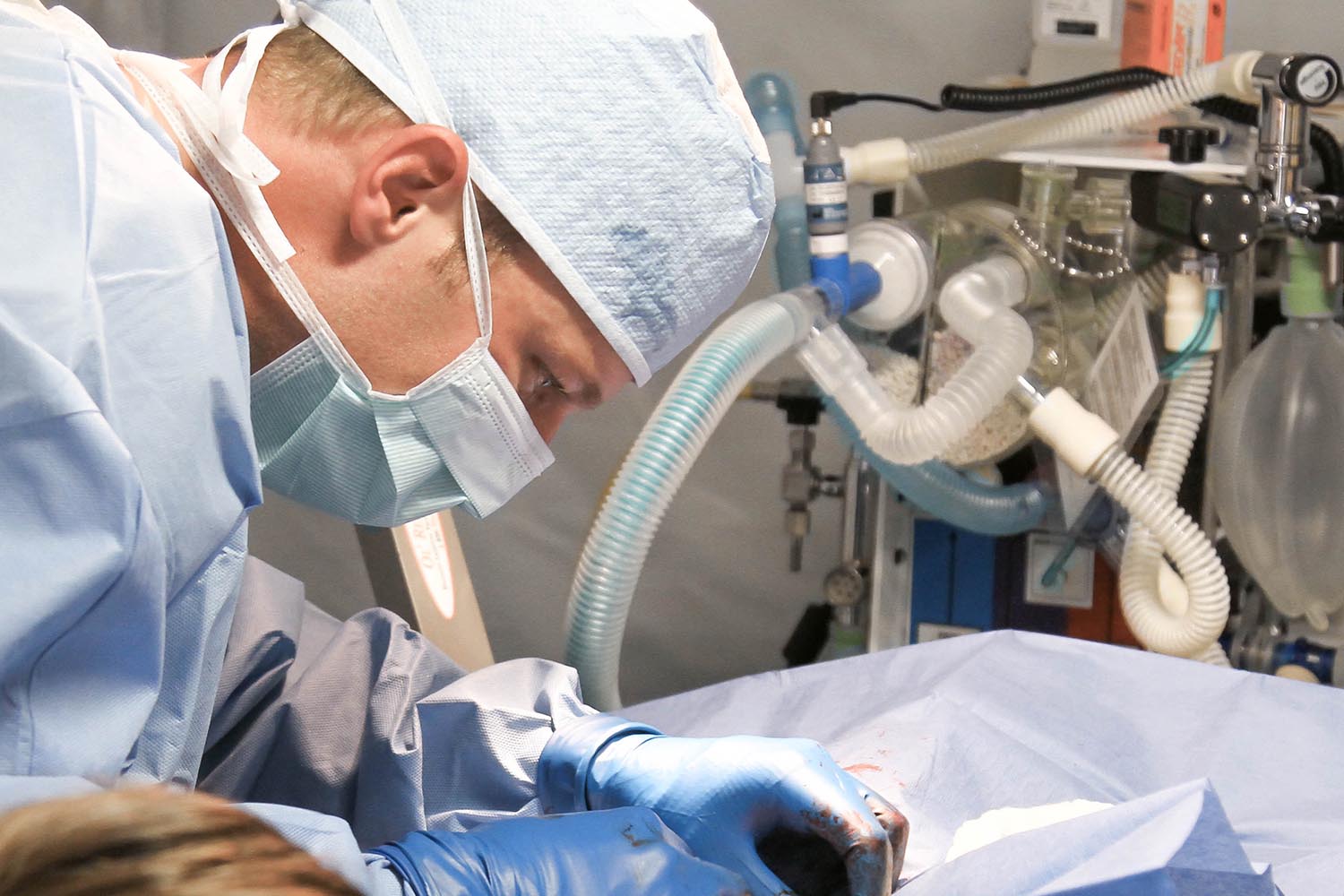
Glue Technique
This is the most recent advancement in the management of varicose veins. This technique uses superglue to stick the vein walls together. In due course, the glue initiates a scarring process and the veins shrivel and get destroyed.
Unlike laser and radiofrequency, this technique does not require numerous injections. One single injection at the point of entry is all that is required. Once complete there is no need for compression stockings. Pain and discomfort are reported to be less after glue usage.
The disadvantage is that the method has been approved for clinical use only recently. Hence there is not much evidence of long term results (10 years and beyond). Endothermal ablation has evidence for a 97% occlusion rate at 10 years. The glue is applied 5cm away from the junction unlike Laser/Radiofrequency (2cm) from the junction. Therefore the risk of recurrence is theoretically high for glue.
If you choose to have glue to treat your veins, you agree to be part of clinical governance pathway meaning you will agree to be seen annually for 5 years to check the leg clinically and the veins by ultrasound.
Procedure | Cost from |
Consultation including ultrasound scan | £200 |
Single leg EVLT | £1800 |
Both legs EVLT | £2300 |
Single leg Sclerotherapy | £500 |
Multiple phlebectomy | £750 |
Clarivein one leg | £2000 |
Clarivein both legs | £2300 |
Glue one leg | £2000 |
Glue both legs | £2300 |
Frequently Asked Questions
- What is Endovenous Laser Ablation (EVLA)?
- What is Radiofrequency and how is it different to laser?
- What is ClariVein®?
- What is Glue technique?
- What is Foam sclerotherapy?
- What is microphlebectomies?
- Can I go home straight after the procedure?
- How long will the procedure take?
EVLA is an established gold standard technique for the treatment of varicose veins and has replaced traditional surgical techniques in the treatment of varicose veins in most cases. The abnormal vein is heated by a laser. A wire with a laser tip is introduced into the vein via a catheter using a minimally invasive keyhole approach. The laser tip is advanced to the highest point to be treated or up to 2cm from any junction with the deep veins. The laser is then activated, which destroys the internal walls of the vein. The body then absorbs the dead tissue, getting rid of the varicose vein. The procedure is carried out under local anaesthetic, using a technique called tumescent anaesthesia, where a large volume of dilute anaesthetic solution is injected along the leg through small needle pricks. It has a 98% success rate and maintains that rate for ten years.
Radiofrequency also uses heat as a modality of treating varicose veins. The difference between radiofrequency and laser is that one uses a microwave to heat and the other uses a laser (light). The results and the procedures are the same but the cost of radiofrequency is higher.
ClariVein®is another technique in the endovenous varicose vein treatment known as mechanochemical venous ablation which utilises a revolutionary catheter tip which spins within the vein, damaging the walls of the vein. A chemical sclerosant is used in conjunction with this to destroy the vein. The advantage of this technique is that it does not generate heat, and therefore does not require the use of tumescent anaesthesia. This means less bruising, no pressure in the leg from anaesthetic, and less post-operative discomfort and a quicker return to normal. This is a newer technique than EVLA, and therefore has less long term data to back its effectiveness. However, current data so far continues to support this modality as a treatment that is shaping up to be as effective as EVLA.
This is the most recent advancement in the management of varicose veins. This technique uses superglue to stick the vein walls together. In due course, the glue initiates a scarring process and the veins shrivel and get destroyed.
Unlike laser and radiofrequency, this technique does not require numerous injections. One single injection at the point of entry is all that is required. Once complete there is no need for compression stockings. Pain and discomfort are reported to be less after glue usage.
The disadvantage is that the method has been approved for clinical use only recently. Hence there is not much evidence of long term results (10 years and beyond). Endothermal ablation has evidence for a 97% occlusion rate at 10 years. The glue is applied 5cm away from the junction unlike Laser/Radiofrequency (2cm from the junction). Therefore the risk of recurrence is theoretically high for glue.
If you choose to have glue to treat your veins, you agree to be part of clinical governance pathway meaning you will agree to be seen annually for 5 years to check the veins by ultrasound and leg clinically.
Injecting a chemical irritant into the vein with air/gas is foam sclerotherapy. It does not involve anaesthesia. The number of injections required depends on the severity of the varicose veins. Most people have very good results. Some have staining for some time before it gets better.
Microphlebectomies is disconnecting the varicose veins so that blood does not flow through them. If blood does not flow through the veins the veins are not visible themselves. This procedure involves local anaesthesia. Patients end up with very good cosmetic result soon after the procedure but the chances of recurrence are high.
All current modalities of treatment of varicose veins are day case/walk in-walkout procedures. Once treatment is completed you will wear either a compression bandage or compression stocking to the treated leg. You will need to be monitored for about half an hour prior to going home. The staff will make you feel comfortable and ensure you are feeling ok.
If you have had avulsions (surgical removal of abnormal veins), you will require a compression bandage, which will be applied following the procedure. You will then be monitored and allowed to go home about half an hour after the procedure with comprehensive post-operative instructions. The compression bandage stays for 24 hours and you can remove them at home a day after.
The procedure tends to take about an hour for each leg but can take longer to treat your vein completely.
- How long before I can resume normal activities?
- How long should we wear the stockings?
- Will I see an improvement immediately?
- What is foam sclerotherapy?
- Will I need a combination of treatment modalities?
- Will I be seen after the treatment?
- What preparation do I need before the procedure?
You should resume normal activities as soon as possible. Most people manage to do so within 1-2 days. There are certain things to avoid, like vigorous activity and hot baths within the first week. We will go through all this with you as it is person-specific.
Gentle exercises are encouraged. No running/swimming for a week. Some people notice lumps and veins that were soft go hard after the procedure. This is normal and will resolve in due course. Patients who are lax with the stockings generally tend to get these changes.
There may be some pain and discomfort for the first few days which is easily controlled by a short course of paracetamol over the counter. You should avoid flying or long journeys for the first 4 weeks due to a slightly increased risk of deep vein thrombosis (DVT)
The minimum time required is one week from the procedure. Most patients feel wearing it for six weeks is more comfortable and gives better results especially if foam sclerotherapy is used as an adjunct modality.
The time it takes to see the results depends on how quickly your body disintegrates the damaged veins. Some patients have seen the results they want within two weeks and for some it takes months. The average time is six weeks. Most patients see initial bruising and inflammation of the treated leg before they see any improvement.
Foam is a combination of a liquid and gas. In this case, we use a chemical sclerosant as liquid and room air or carbon dioxide as gas to create foam. This is injected into the varicose veins. The chemical sclerosant is an irritant to the veins and this causes inflammation and later scarring and shrivels the veins.
Most patients need a combination of modalities. The modality of the treatment is chosen as per the vein presentation, position and size.
Mr Sridhar will see his patients after six weeks to assess the results with ultrasound and for clinical assessment.
- Do not come on an empty stomach
- Wear loose-fitting trousers as you will have a compression bandage after the procedure
- No creams or lotions on the skin
- You cannot drive back home so ask a friend to pick you up or take a cab home
- Take paracetamol a maximum of 4g a day for a week so better to stock it up at home.
Consent form for medical photography | |
Consent form for EVLT varicose procedures | |
Leaflet for EVLT varicose procedures | |
Consent form for sclerotherapy | |
Leaflet for sclerotherapy | |
Consent form for Glue Therapy | |
Leaflet for for Glue Therapy |
Send us
your message
There are three 3 easy ways to contact us:
-
Call us now on 07492 185412
-
Request a callback, using the form below
-
Send us an email care@integura.co.uk, or fill in the form below.
CLINIC ADDRESS
Integura
No 7 Blyth Road
Bromley BR1 3RS
REGISTERED ADDRESS
Adithya Enterprises Limited
97b plaistow lane
Bromley BR1 3AR
Copyright by Integura 2022. All rights reserved.
Copyright by Integura 2022. All rights reserved.

